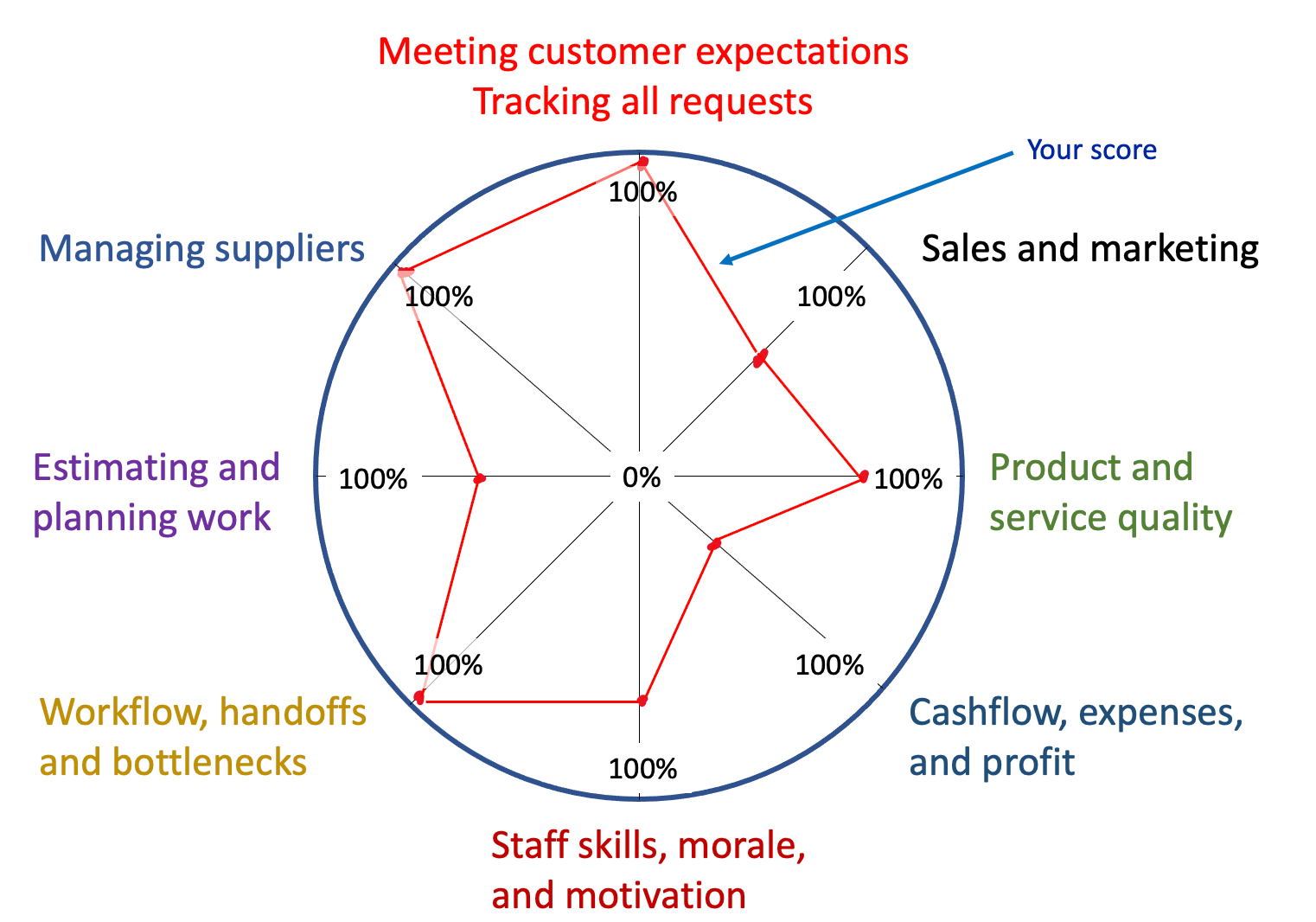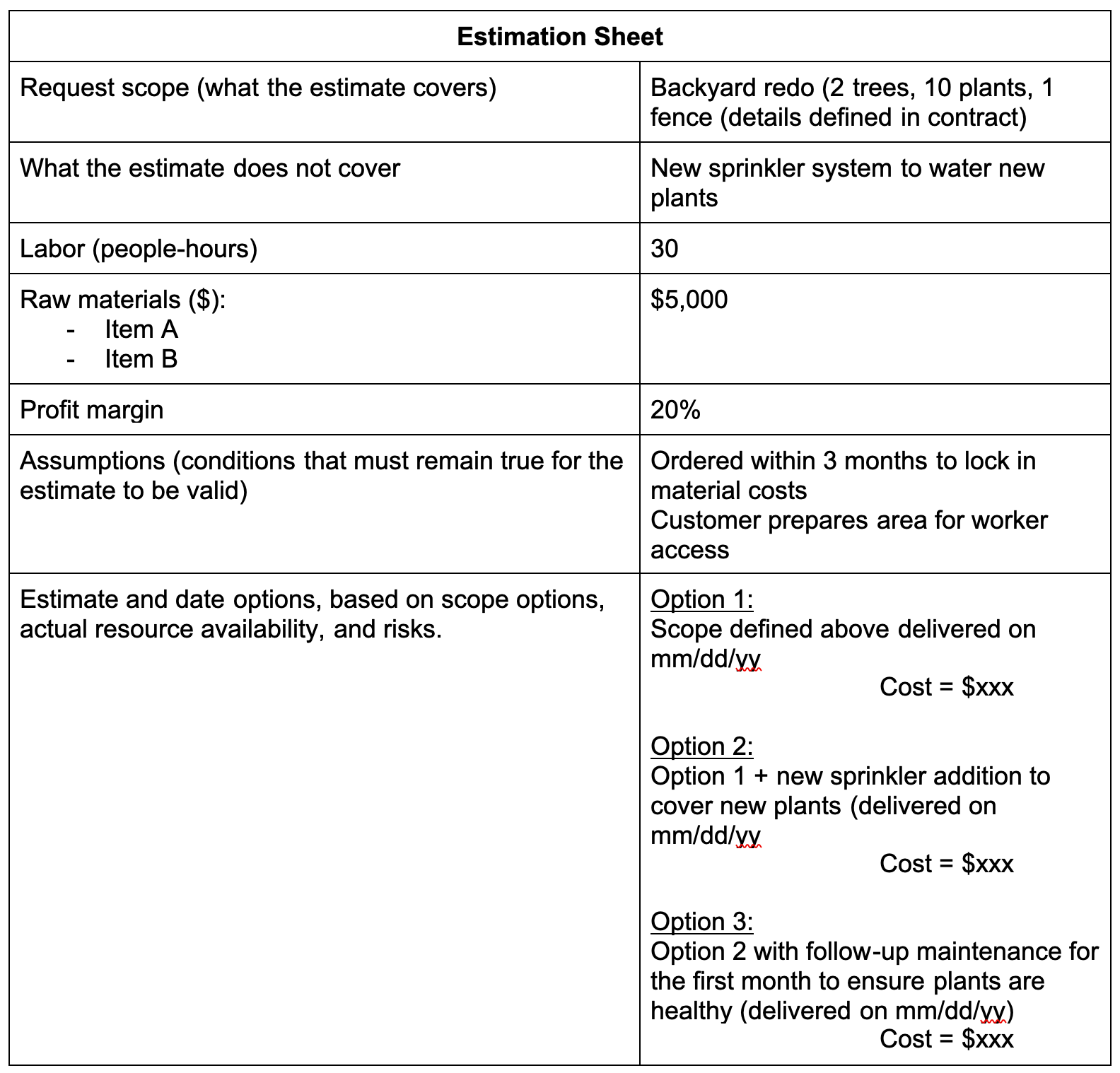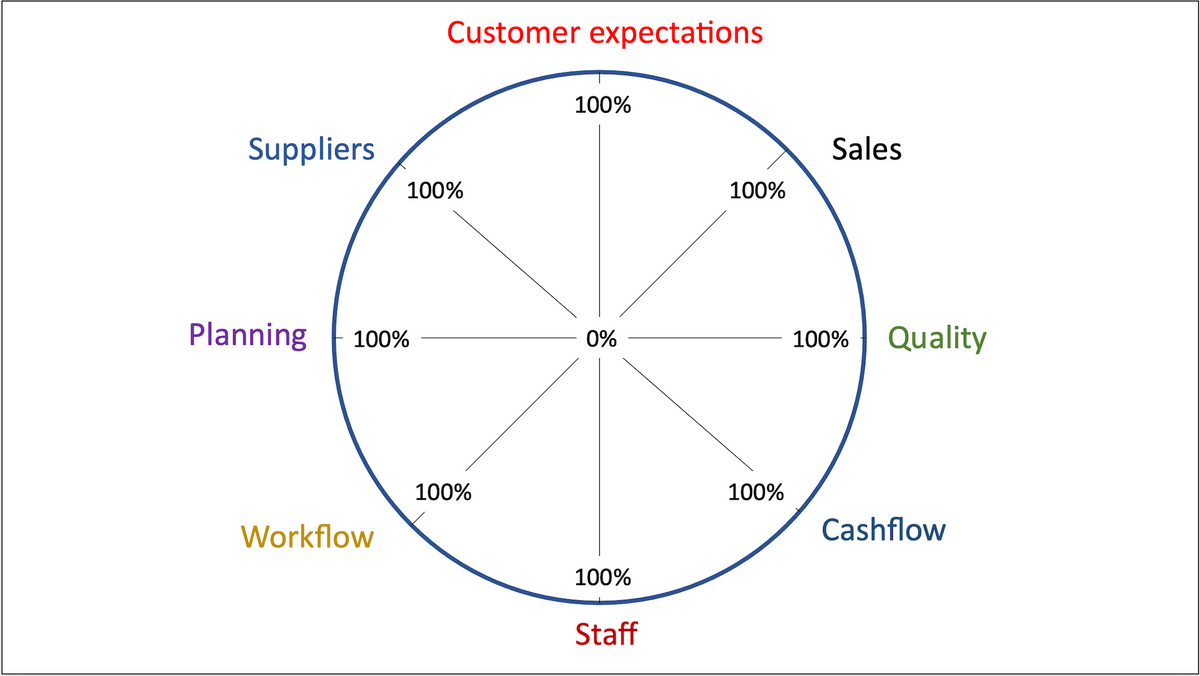Related video: https://youtu.be/1jKaOsiPcOw
Introduction
Here are eight criteria of great companies that I have worked with over the last 30+ years.
• Meeting customer expectations and tracking all requests
• Sales and marketing
• Product and service quality
• Cashflow, expenses, and profit
• Staff skills, morale, and motivation
• Workflow, handoffs and bottlenecks
• Estimating and planning
• Managing suppliers
The eight items are not listed in any order since the importance of each one will be relative to your own goals and business needs.
Think of the list as a wheel on a car, where a low score in any area is comparable to a deflated tire. You don’t have to score one hundred percent on each item, but high enough to get the results you want.

Here is a summary of each item and some links to related articles and videos. Read the descriptions and select a few areas to work on.
Meeting customer expectations and tracking all requests
This is probably the most important item in any company since customers are the primary source of income. If you are not scoring well on this item, I would work on it first.
Related YouTube video: https://youtu.be/dh1GHyda6bc
Sales and marketing
Marketing is understanding the needs of your audience and educating potential customers on what is possible. Sales is helping a customer solve a problem with a product or service and trading that solution for money.
Related YouTube video: https://youtu.be/EfBc9C83Hn4
Product and service quality
Customers want products and services that work. This would be an area to improve if your product or service is not consistently good or you waste time because of customer complaints.
Related article: https://www.improvingyoursmallbusiness.com/quality/
Cashflow, expenses, and profit
Having enough cash on hand is essential to pay bills without having to borrow money. There are only a few hard-and-fast rules here.
- Spend less than you earn
- Save the remainder for cash flow and investments in the business
- If you need to borrow, shop around for a low interest rate and pay the loan early to reduce the amount of interest
82% of small businesses fail due to cashflow problems [1]. If your cashflow or profits are consistently low, then:
- Sell old inventory that you might not be able to use in current products
- Make sure that you are pricing items appropriately (see the section below on estimating and planning)
- Reduce expenses. For example, move into cheaper office space or don’t replace staff that leave. Instead, determine if tasks can be eliminated, automated or handled by remaining staff
- Buy cheaper or second-hand stuff if you are cash-poor
- Get your staff involved in your problem; they might have some good ideas and will feel more committed to the company
Staff skills, morale, and motivation
A good use of money is to train staff to perform better, work more efficiently, and keep customers happy. Education and training doesn’t necessarily have to be expensive. There are numerous online resources and YouTube videos you can start with for free.
Morale and motivation doesn’t require lots of money, either. There is a lot you can do with good leadership to increase morale and motivation.
For example:
- Ensure that you treat employees with respect
- Allow them some flex time and choice of when and where they work, within the constraints of the job
- Let them decide how to improve their work environment and job performance
- Organize social events within the workday and after work. Let them pick what to do and where
- If you have the resources, treat your staff to meal at a fancy restaurant or entertainment. Ask them for their input
- Provide surprise bonuses when the company does well
- Make their work environment and benefits better than average (e.g., healthcare, restrooms, coffee machine, computers and office space)
- Offer retirement-fund matching
- Ask them every six months what they don’t like about the workplace and fix it
- Provide something that helps them with their work-life balance (e.g., exercise facilities or membership, daycare assistance, further education assistance)
Related YouTube video: https://youtu.be/wNDFXo-wW_Q
Workflow, handoffs and bottlenecks
Your company workflow is the collection of steps a customer request goes through from beginning to end that includes handoffs and potential bottlenecks.

Things to look out for are:
- Customer requests that don’t follow a uniform set of steps, leading to confusion, and numerous mistakes and bottlenecks
- Requests that are lost when there are handoffs between one person and the next
- Work that builds up in one area because of capacity, skill or tool issues
- Staff that are not trained in the correct workflow, leading to errors and delays
Estimating and planning work
Deadlines and estimates drive most decisions in business, either because they lead to revenue, or they are one domino in a chain of events that results in revenue.
For custom work, I recommend that you have a standard list of component items so that nothing is missed. For example, you could make an estimation table like the one below:

If your profits are consistently low, then look at your expenses and use a standard table to re-estimate your prices.
If you are unsure what your customers are willing to pay for your products and services, ask a few of them. Sometimes I am surprised at what small businesses charge and I would have paid more. Or I would have paid more if the product or service had been better. You will never know what customers are willing to pay until you ask.
If you charge more than your competitors, then explain in your marketing materials why you are different. Do you use better materials, have better trained staff, or offer better warranties?
Managing suppliers
Suppliers can cause numerous delays and unplanned expenses if they are not selected and managed well.
Here are some steps to consider for your critical suppliers.
- Select vendors based on defined criteria (e.g., past performance, published customer reviews, product trials, value-for-money compared to competitors, ability to respond to requests)
- Develop written agreements with each supplier (e.g., an email or a one-page agreement that can be signed)
- Include milestones in the agreement that can be the basis for payment and tracked
- Verify that the milestones and deliverables are satisfied before acceptance and payment
Conclusion
There are numerous practices that make a small business successful. This article covers eight critical ones. Look at each and score them and see where you are. Add your own success criteria that you believe helps you run your business.
Need help?
I can help you get started, fix a problem or point out opportunities. Contact me using the contact form at https://www.improvingyoursmallbusiness.com/contact/
Reference [1] https://www.score.org/resource/blog-post/1-reason-small-businesses-fail-and-how-avoid-it


